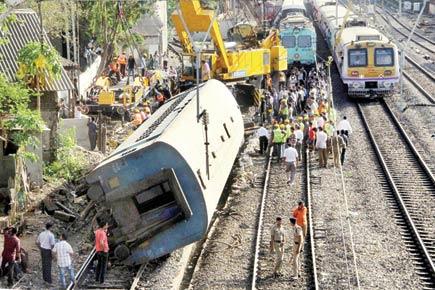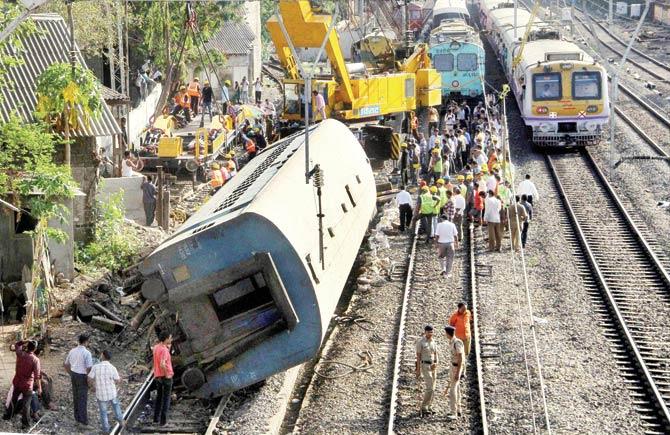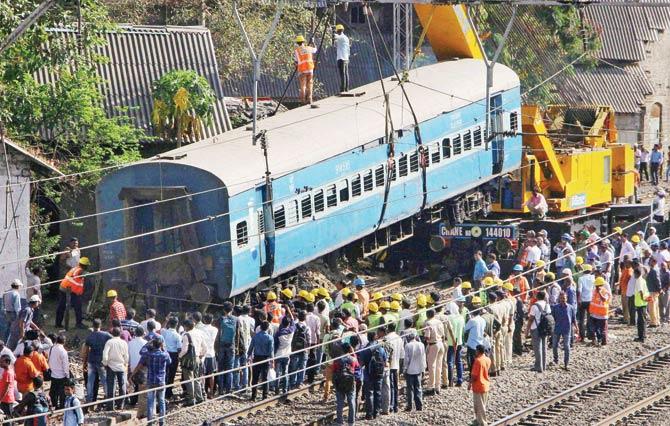Instead of merely tilting — like coaches do in most derailments — it turned turtle; Western Railway officials suspect muck and concrete near the crossing could have tipped it over

In the wee hours of yesterday, a coach from a long-distance train derailed and turned turtle near the Lower Parel station. Western Railway (WR) officials suspect that muck and concrete materials could have led to the coach flipping over itself instead of merely tilting, like it does with most derailments.
ADVERTISEMENT

“Normally when a coach derails the wheels come off the tracks and tilt partially. But in this case, we found loose soil, concrete and garbage right next to the track before the entrance to the yard. We assume that when the coach hit this portion, it capsized, making things more difficult,” said a senior WR official.

By 9 am, the coach was finally re-railed but it had already hit the suburban train services, where 100 services were cancelled. Pics/PTI
The 13-coach train was entering the yard at Lower Parel long distance train around 2.15 am when the incident occurred. Two coaches, including the one that derailed, were supposed to be scraped as they had come to the end of their over 15-year life. The derailed coach was the second one after the engine and sources said that when it entered, it is likely that a misappropriation in the height of the buffer with the following coach possibly led to the derailment.
Buffers
Sources explained that normally the buffers — spring-like equipment at the end of the coach — of two adjacent coaches should be 75 mm in distance. The authorities feel that in this case, the distance was more than that. Hence, when the second coach entered, the coach behind it supposedly lifted, after which the second coach derailed. The prescribed height of the buffer from the rail is 930 mm-1005 mm.
The train was moving at a speed of 8 kmph and had reached the crossover. Sources agreed that derailments are more frequent on or near crossovers where tracks inter change. In this case, the train had to cover less than 500 meters – part of it was on the Churchgate-Virar slow line – but after the derailment, the coach was dragged for nearly 70 meters.
Thousands stranded
After the derailment, lifting and re-railing the coach was another problem. Officials claimed there were overhead wire (OHE) poles that made it difficult to get the crane and accident relief train to the spot. They managed to start the process only by 6 am.
By 9 am, the coach was finally re-railed, but not before taking away the 11-coaches, engine and first coach inside the yard. This had already hit the suburban train services as the slow line towards Virar was affected. Thousands of people were stranded in the melee as trains ran late by 20-40 minutes. Slow trains between Matunga, Dadar, Elphinstone Road, Lower Parel and Mahalaxmi weren’t running as well.
Slow trains were diverted on fast tracks while several were even cancelled through the day. “We had to cancel over 100 services, but we ran 20 additional services,” said Ravinder Bhakar, chief PRO, Western Railway (WR).
By 10.27 am, WR restored the Churchgate-bound slow track that was affected, restored the Virar-bound slow track by 11.10 am and ran the first local on it to and from Bhayander at 11.22 am. “We have instituted a committee to determine the cause of derailment,” said Mukul Jain, Divisional Railway Manager (Mumbai), WR.
 Subscribe today by clicking the link and stay updated with the latest news!" Click here!
Subscribe today by clicking the link and stay updated with the latest news!" Click here!






